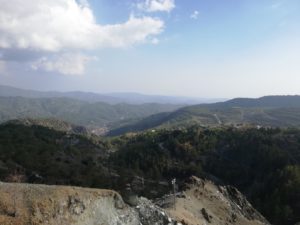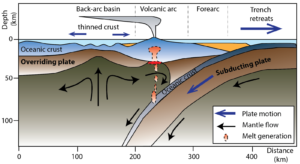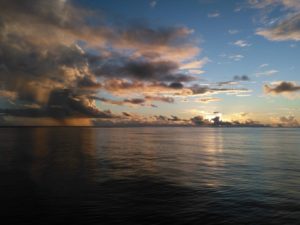
Dr. Anouk Beniest, an Assistant Professor in Tectonics at the Vrije Universiteit Amsterdamat, is an interdisciplinary earth scientist, bringing together geology, geophysics and geodynamics to help us understand complex geological problems. Her research revolves predominantly around plate tectonics, with a focus on extensional systems and she has kindly put together this blog post to convince you that back-arc basins are the most influential tectonic structures affecting ocean circulation, as well as how important they could be in the energy transition.
I’m at the top of Mount Olympus, the highest mountain on the island of Cyprus (Fig. 1). Olivine-rich mantle rocks, some intact, others completely altered to serpentinite surround me. I’m amazed to see these kilometers-deep mantle rocks, now exposed at 2000 m altitude. Cyprus is one of these unique places where oceanic crust is emplaced on land, in geological terms an ‘ophiolite’. Bear in mind that it is not just your regular ophiolite, it is actually one of the few very nicely preserved ones and still has the complete rock sequence, from mantle to ocean sediments, in
place.
It is already impressive to find these mantle rocks on the top of a mountain, but for me the most fascinating part is that the oceanic crust of the Cyprus ophiolite was formed in a back-arc setting. The back-arc domain develops when a subducting plate retreats or rolls back (Fig. 2). This roll-back of the subducting slab causes the overriding plate to thin behind the volcanic arc that was formed in response to the subduction. If roll back is continuous for long enough, the thinned crust in the back-arc domain will break, forming an oceanic ridge in which spreading will start to form new oceanic crust: the back-arc basin is born.
I’m triggered by back-arc basins, partly because there is still so much to discover, but also because they have quite an influence on humanity.
One point that I find very fascinating, is that even though back-arc regions occupy a relatively small surface of the oceanic domain (Fig. 3), I estimate a total surface around 10%, they tend to occur in crucial locations for oceanic currents to develop or stagnate. Arguably the most important back-arc system is located in the Scotia Sea, in between South America and Antarctica. Due to back-arc basin opening, the Drake Passage gateway formed, allowing the Antarctic Circumpolar Current (ACC) to develop. When the ACC was established, it started to deflect the warm waters from the equator, cooling the complete Antarctic continent so much that permanent ice caps developed, which eventually lead to our climate today in which we humans and other organisms thrive quite well.
My second point of fascination is that back-arc basins are hydrothermally active, which is not uncommon by itself, but because of this interaction between the subducting plate and back-arc spreading, the newly generated crust is rich in earth materials that we humans need for our products. More specifically, many of these materials are needed for the energy transition to maintain the climate (which is caused by back-arc basin opening!) we currently have.
Back-arc basins are fascinating structures. They have a major control on long-term stable, but also changing, climatic conditions due to gateway opening and closure and they produce materials that we like to use in products and devices. I am happy that back-arc basins are there. Without them, the world would be a different place.







